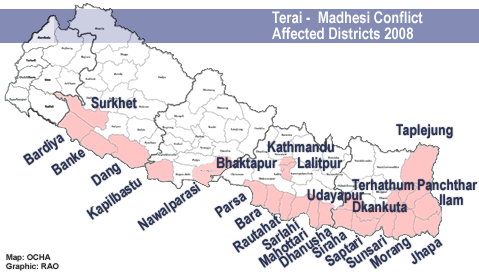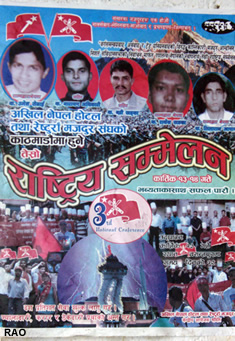|
Nepal
2008: Facts on the Conflict
|
|
Violence,
abductions on the rise in volatile southeast
|
 |
RAJBIRAJ,
16 July 2008 (IRIN)
 |
| "I
was given seven days to pay a huge ransom or face death," a fear-stricken
55-year-old woman who requested anonymity told IRIN in southeastern Nepal
on 15 July.
Two
days earlier, she had fled her home in Kanchanpur village in southern Nepal's
Terai Region and was now displaced following death threats by Nepal's Madhesi
Mukti Tigers (MMT), a pro-Madhesi group who had
demanded nearly US$2,000.
The
group demanded the money to help fund their armed struggle for the rights
of ethnic Madhesi in the Terai Region of southern
Nepal. |
|
Former
head teacher Maina Kaderi, said he had been forced to leave his home in
Saptari District in the Terai Region after failing to find a job for the
relative of a member of the Madhesi Virus Killers
(MVK), another armed group. "I was warned to leave my home immediately
or I could be shot dead" I had to leave my job and house to protect my
family."
According
to local non-governmental organsations (NGOs), human rights activists and
government agencies, Saptari is considered to be one of the most dangerous
areas in southeastern Nepal: Violence, abductions and killings are on the
rise due to the activities of armed ethnic-based groups.
There
are some 15 armed political groups in the Saptari and nearby Siraha districts
alone, say the police. The Madhesi Virus Killers (MVK), the Madhesi Mukti
Tigers (MMT), the Sanyukta Terai Jankranti Party (STJP) and four factions
of Janatantrik Terai Mukti Morcha (JTMM) - all considered arch rivals -
are among the most violent.
 |
| "Abductions
and crimes are growing dangerously and the fragile security situation is
being exploited by criminal gangs who have turned abductions into a lucrative
business," said local human rights activist Shambu Nanda Chaudhary of Manav
Adhikar Sanjal, a local NGO. |
|
The
police in Saptari say they are fighting crime, but locals complain they
are given no protection.
Meanwhile,
the armed groups deny involvement in crime: "Our armed struggle is to bring
about a Madhesi autonomous province and ensure the
Madhesi find employment in every state sector. We are not involved in criminal
activities," Dewan Singh, a leader of MVK, told IRIN by telephone from
an undisclosed location.
He
said, however, that political groups like JTMM had been involved in abduction
and extortion.
| Insecurity
affecting aid programmes |
 |
| The
growing number of displaced persons, along with attacks on aid workers
and government staff, have now become a serious source of concern, according
to the NGO Federation of Nepal (NFN).
"Government
agencies and NGOs are unable to work actively and freely these days," Binod
Chaudhary, NFN's district chairman in Saptari, said.
Insecurity
was being blamed for the increasing absence of state officials in the Village
Development Committees (VDCs) - important local government executive bodies
which implement aid programmes in villages. |
|
Government
officials in VDC offices say they are unable to work in the villages due
to insecurity, and are themselves often displaced: "We can't go to the
villages as there is absolutely no security for us. As soon as we enter
the villages, armed groups come and ask for donations and often abduct
or threaten to kill us," government officer Dhak Bahadur Adhikari, the
district-level chairman of the Nepal Civil Servants Organisation (NCSO),
told IRIN.
Over
100 officials in Saptari District had been unable to return to their VDC
offices, he explained.
"Government
officers are unable to enter villages due to the activities of the armed
groups. Many have been transferred or gone on leave. Many probably will
not return," said Ram Kumar Yadav, a member of the VDC Rights Protection
Centre.
A
new Nepal Situation Overview, published every two weeks by the UN Office
for the Coordination of Humanitarian Affairs (OCHA) in Nepal, said the
field presence of government staff working with local bodies had been drastically
reduced due to insecurity.
Credit
IRIN 2008
Copyright
© UN Office for the Coordination of Humanitarian Affairs 2008
[
This report does not necessarily reflect the views of the United Nations]
Integrated
Regional Information Networks (IRIN), part of the UN Office for the Coordination
of Humanitarian Affairs (OCHA).
| Madhesi
factbox |
 |
 |
 |
 Nepal's
largest
ethnic group; make up about one third of Nepal's 27 million people Nepal's
largest
ethnic group; make up about one third of Nepal's 27 million people
 Concentrated
in the lowland Terai region, southern Nepal, the country's industrial and
agricultural heartland Concentrated
in the lowland Terai region, southern Nepal, the country's industrial and
agricultural heartland
 Traditionally,
their main ethnic rivals are the politically dominant hill people known
as Pahades Traditionally,
their main ethnic rivals are the politically dominant hill people known
as Pahades
 Comprised
of various sub-groups with several different languages and dialects and
have only recently developed a political consciousness and unity of purpose Comprised
of various sub-groups with several different languages and dialects and
have only recently developed a political consciousness and unity of purpose
 Campaign
for regional autonomy for the Terai, a federal Nepal, and greater representation
in parliament Campaign
for regional autonomy for the Terai, a federal Nepal, and greater representation
in parliament
 Militant
factions such as the Madhesi People's Rights Forum (MPRF) and the Janatantrik
Terai Mukti Morcha (JTMM) have carried out violent acts Militant
factions such as the Madhesi People's Rights Forum (MPRF) and the Janatantrik
Terai Mukti Morcha (JTMM) have carried out violent acts
 Not
allied in any way to the Maoists who have separate political goals Not
allied in any way to the Maoists who have separate political goals
 Include
some of the most impoverished and disadvantaged castes in Nepal such as
Badis (traditional sex workers) and Kamaiyas (bonded labourers) Include
some of the most impoverished and disadvantaged castes in Nepal such as
Badis (traditional sex workers) and Kamaiyas (bonded labourers)
According
to rights activists, Maoist leaders are unable to control their supporters. |
|
 |
 |
 |
 |
External Links |
|
More
on Nepal's Nationalities
|
 |
 |
 |
|
Nepal
People |
|







